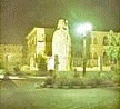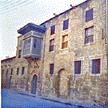
Visit Kypros-Net a new WEB source on Cyprus

 NICOSIA: The
Capital
NICOSIA: The
CapitalNicosia is the capital of Cyprus, a status it has enjoyed for 1000 years since the 10th century, though its beginnings date back 5000 years to the Bronze Age. It lies roughly in the centre of the island in the Mesaoria Plain, flanked by the beautiful northern range of Kyrenia mountains with its distinctive 'Pentadaktylos" - the five finger mountain. There are various suggestions as to the origin of the name Nicosia - or 'Lefkosia' In Greek - but the most likely one is linked to the popular tree, the tall 'Lefki ' which once adorned the city.
Seat of Government, Diplomatic headquarters and cultural centre of Cyprus, the capital presents two distinct faces: the old, original part of the city, surrounded by sturdy Venetian walls over 400 years old, and a busy modern metropolis which has a population of 171.000 together with the suburbs. . .
Within the large area encircled by the strong bastion walls that served to protect the town for centuries are many places of great historic interest.
The central Eleftheria Square links old Nicosia with the elegant modern city that has grown up outside the walls, where hotels, offices restaurants and gardens blend happily with the fine old houses and colonial buildings of this cosmopolitan city.
Priceless and fascinating collection of Cypriot antiquities and art
treasures from the Neolithic Age to the early Byzantine Period.
2. BYANTINE MUSEUM AND ART GALLERIES
Arch. Makarios III Foundation, Cultural Centre, within the
Archbishopric, Arch. Kyprianos Square Tel: (02) 456781.
Largest collection of icons on the island, covering the period from
9th to 18th century. The Art Galleries contain oil paintings, maps,
lithographs etc.
3. FOLK ART MUSEUM
Within the Old Archbishopric, Arch. Kyprianos Square Tel: (02) 463205.
Wide collection of Cypriot folk art of the 19th and early 20th
century, including wood-carved objects, tapestry, embroidery, pottery,
national costumes and hand-woven materials.
4. NATIONAL STRUGGLE MUSEUM
Near the Archbishopric, Arch. Kyprianos Square Tel: (02)30-2465
Documents, photos and other memorabilia of the 1955-1959 National Liberation Struggle.
5. AYIOS IOANNIS CATHEDRAL
Within the Archbishopric, Arch. Kyprianos Square.
Built by Archbishop Nikiforos in 1662, the recently restored 18th century wall paintings depict biblical scenes and the discovery of the tomb of Saint Barnabas at Salamis. Dedicated to Ayios loannis (Saint John).
6. ARCHBISHOPRIC

Centre of the Cyprus Orthodox Church, the new Archbishopric built in a
neo-byzantine style in 1960, contains the private suite of the late
Archbishop Makarios. Open to the public only on special occasions.
7. HOUSE OF HADJIGEORGAKIS KORNESSIOS
Patriarch Gregoriou Street near the Archbishopric.
 Originally a Venetian Building. It is probably the most important 18th
century building in Nicosia. It was once the house of the Dragoman
Hadjigeorgakis Kornessios. The house is being restored and will house
the Cyprus Ethnographic Museum. Hadjigeorgakis Kornessios house has won
the Europa Nostra award in 1988.
Originally a Venetian Building. It is probably the most important 18th
century building in Nicosia. It was once the house of the Dragoman
Hadjigeorgakis Kornessios. The house is being restored and will house
the Cyprus Ethnographic Museum. Hadjigeorgakis Kornessios house has won
the Europa Nostra award in 1988.
8. FAMAGUSTA GATE
Nikiforos Phokas Avenue Tel: (02) 430877
The Venetian walls which completely encircle the old city have a
circumference of 4.5 km and possess eleven heart-shaped bastions. There
were only three entries to the city through gates, in the north, south
and east. One of these gates, the Porta Giuliana, called the Famagusta
Gate has been restored and is now the Nicosia Municipal Cultural Centre.
The large imposing gate itself leads into a long passage with a central
cupola, which cuts through the walls and comes out in the moat. On both
sides are high, stonewalled guard-rooms. The restored passage and rooms
arc used for exhibitions, conferences, Iectures and various performances.
The oId quarter of the town, close to the Famagusta Gate, is also beinR
restored.
9. CHRYSALINIOTISSA CHURCH
Within walking distance from the Archbishopric. Considered the oldest
Byzantine church in Nicosia it is dedicated to 'Our Lady of the Ciolden
Flax' and is believed to have been built in 1450 by Queen Helena Palaeologos.
10. OMERIYEH MOSQUE
Near the Old Municipal Market within the walled city.
Converted into a mosque in 1571 by Mustapha Pasha, who believed that the original 14th century Augustinian church of St. Mary's, was built on the spot where prophet Omer rested when visiting Nicosia. Most of the original building was destroyed by Ottoman artillery. Engraved tombstones of the Lusignan period were used to re-floor the mosque. Remains of late Venetian building can be seen near the east end of the mosque.
11. PHANEROMENI CHURCH
Onassagoras street, within the old city.
Built in I872 this used to be the largest church in Nicosia. The
marble mausoleum to the east of the church contains the relics of
he bishops and priests executed by the Turks in 1821.
Built by Archbishop Germanos II in 1695 this is an interesting example
of the Franco-Byzantine style. The rich interior, the
unusually wide iconostasis and silver-covered icon indicatc this was once
a 'society' church.
13. LAIKI YITONIA
Rcstored pedestrian area within the walled city, east of' Eleftheria
Square. Charming winding alleys with traditional houses and shops, restaurants,
galleries, all lovingly restored as typical examples of Cypriot urban
architecture of a bygone, more graceful age.
14. STATE COLLECTION OF CONTEMPORARY ART
Corner Stassinos Ave and Crete street Repressentative collection of paintings and sculpture by Cypriot artists 1930-1980.
15. ST. PAUL'S ANGILICAN CATHEHDRAL CHURCH
Though officially called a Cathedral, this is the parish church for Anglican residents, and was built in I893 in a style reminiscent of many English village churches.
16. MUNICIPAL THEATRE
Museum street, opposite the Cyprus Museum.
This spacious theatre in neo-classical style was completed in 1967. It has a seating capacity of 1200 and is used for performances by the Cyprus Theatrical Organisation, musical concerts and recitals, dance performances and for various ceremonies.
17. KYKKO METOCHI
Prokopiou street, Engomi.
Monastery dependency of the famous Kykko Monastery, dating from 1890.
18. CYPRUS HANDICRAFT SERVICE
Athalassa Avenue Tel:(02) 30-5024 (Turn right at the beginning of
Nicosia-Limassol highway, traffic lights).
The, aim of the government-run centre is to promote and improve
traditional folk art and craft skills by helping artisans to improve their
techniques and maintain the quality of their products. The Centre includes a
showroom-shop with a wide selection of Cyprus handicrafts, and also shops in
Laiki Yitonia and in all other towns.
19. THE INTERNATIONAL CONFERENCE CENTER
In Nicosia you
will find the most sophisticated Conference
Centre on the island which accomrnodates
more than 1,OOO delegates.
1. ANCIENT CITY KINGDOM OF IDALION AND THE BYZANTINE CHURCH AT
PERACHORIO
19 km south of Nicosia.
The site of this ancient city kingdom has not yet been fully excavated, but on the high ground, outside the present village of Dhali, part of the ancient walls of the city can be seen. In this area Adonis, mythical lover of the goddess Aphrodite, was killed by a wild boar sent by her jealous husband.
At the nearby village of Perachorio the church of the Holy Apostles contains very beautiful 12th century frescoes.
2. PANAYIA CHRYSOSPILIOTISSA
Near Deftera village, 11 km southwest of Nicosia.
Dedicated to Our Lady of the Golden Cave, the catacomb structure, an
enlarged natural cave indicates the church, dates back to the early Christian
period. Unfortunately its painted interior is hadly damaged. A religious
fair is held near the church on 15th August.
3. TAMASSOS
Tamassos, with its rich copper works, was a city kingdom of ancient Cyprus and of great importance throughout early history. Excavations have produced the Royal Tombs and copper workshops associated with Aphrodite-Astarte.
4. AYIOS HERAKLEIDIOS MONASTERY
Politiko village, 1/2 km from the Royal Tombs.
When Saints Paul and Barnabas came to Cyprus, they were guided to Tamassos by Herakleidios, whom they later ordained as Bishop of Tamassos. He was martyred at the age of 60 and buried in the cave where he had lived and preached. The Monastery was founded in 400 AD, destroyed and rebuilt several times until Archbishop Chrysanthos renovated the church and cells in 1773. The skull and a bone from the hand of the saint are kept in a silver gilt case, in the church which is decorated with fine frescoes and icons.
5. MACHAIRAS MONASTERY
41 km south of Nicosia, through Deftera and Pera villages.
Founded by two monks in 1148, when an icon of the Virgin Mary was found
in a nearby cave. Set in a picturesque dip in the Makhairas mountains, it
is the scene of a large religious fair on 15th August.
6. PHIKARDOU
1 1/2 km east of Gourri village (Road Makhairas-Nicosia Via Klirou).
The whole village has been declared an ancient 'monument' in order to preserve the remarkable woodwork and folk architecture of the 18th century houses. The house of Katsinioros and Achilleas Demetri some parts of which go back to the 16th century, have been restored as vivid examples of rural architecture. They received the EUROPA NOSTRA award in 1987.
7. AYIOS PANTELEIMON
1 1/2 km north west of Agrokipia village.
An 18th century monastery with a gabled roof, restored in the early 1960s and now serving as a retreat for three nuns.
8. ARCHANGELOS MICHAEL MONASTERY
Off the Nicosia-Anthoupolis Road, 10 minutes drive from Nicosia.
The church dates back to the Byzantine period, with rebuilding carried out in 1636 and in 1713 when it was purchased by Kykko Monastery. Founded by Archbishop Nikiforos whose tomb can be seen in the narthex of the church. The iconostasis dates to 1650 and there is a 1785 fresco of the Archangel Michael to whom the monastery is dedicated.
9. PERISTERONA
27 km from Nicosia on the Nicosia-Troodos road .
The church, dedicated to Saints Barnabas and Hilarion, was probably erected in the early 10th century, and is an outstanding example of Byzantine architecture. Next to the church stands the Turkish mosque of Peristerona, witness to the long and peaceful co-existence between the Greek Cypriots and Turkish Cypriots of the village, and the whole of Cyprus. in a time when Turkey had not yet adopted its partitionist and expansionist policy.